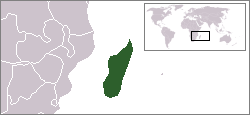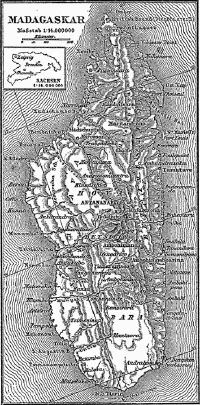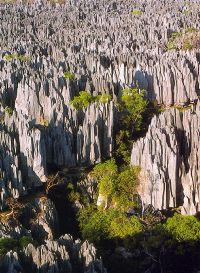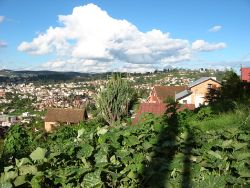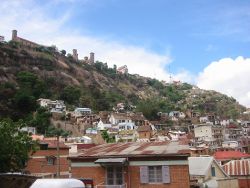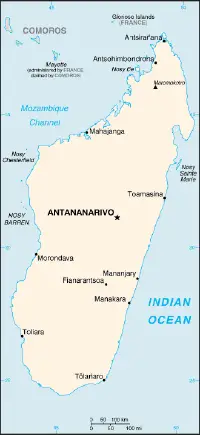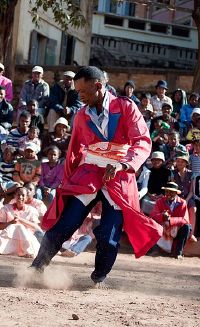Madagascar
| Republic of Madagascar Repoblikan'i Madagasikara République de Madagascar |
||||||
|---|---|---|---|---|---|---|
|
||||||
| Motto: Fitiavana, Tanindrazana, Fandrosoana (Malagasy) Amour, patrie, progrès (French) "Love, Fatherland, Progress"[1] |
||||||
| Anthem: "Ry Tanindrazanay malala ô!" Oh, Beloved Land of our Ancestors! |
||||||
| Location of Madagascar
|
||||||
| Capital (and largest city) | Antananarivo 18°55′S 47°31′E | |||||
| Official languages | Malagasy, French | |||||
| Demonym | Malagasy[2] | |||||
| Government | Unitary semi-presidential constitutional republic | |||||
| - | President | Andry Rajoelina | ||||
| - | Prime Minister | Christian Ntsay | ||||
| Independence | from France | |||||
| - | Date | June 26, 1960 | ||||
| Area | ||||||
| - | Total | 587,041 km² (47th) 226,597 sq mi |
||||
| - | Water (%) | 0.009% | ||||
| Population | ||||||
| - | 2021[2] estimate | 27,534,354 (53rd) | ||||
| - | 1993 census | 12,238,914 | ||||
| - | Density | 35.2/km² (174th) 91.1/sq mi |
||||
| GDP (PPP) | 2019 estimate | |||||
| - | Total | $45.948 billion[3] | ||||
| - | Per capita | $1,697[3] | ||||
| GDP (nominal) | 2019 estimate | |||||
| - | Total | $12.734 billion[3] | ||||
| - | Per capita | $471[3] | ||||
| Gini (2012) | 42.6[4] | |||||
| Currency | Malagasy ariary (MGA[2]) |
|||||
| Time zone | EAT (UTC+3) | |||||
| - | Summer (DST) | not observed[5] (UTC+3) | ||||
| Internet TLD | .mg | |||||
| Calling code | [[++261[5]]] | |||||
Madagascar, officially the Republic of Madagascar, is an island nation in the Indian Ocean, off the eastern coast of Africa with a population of more than 18 million. The main island, also called Madagascar, is the fourth largest island in the world. It is the home of five percent of the world's plant and animal species, 80 percent of which are unique to Madagascar. Among its most notable examples of biodiversity are the lemur infraorder of primates, three endemic bird families and six endemic baobab species.
The adjective (language, ethnicity and citizenship) derived from Madagascar is Malagasy (pronounced "mal-gazh"). The primary language spoken in Madagascar is Malagasy.
History
Archaeologists place the first arrival of humans on the island to the years between 200 and 500 C.E., when seafarers from southeast Asia, probably Borneo or the southern Celebes, arrived after crossing thousands of miles of open ocean in their outrigger canoes. The feat represented the western-most reach of the great Austronesian expansion.
The written history of Madagascar began in the seventh century, when Arabs established trading posts along the northwest coast. European contact began in the 1500s, when Portuguese sea captain Diego Dias sighted the island after his ship became separated from a fleet going to India. In the late seventeenth century, the French established trading posts along the east coast. From about 1774 to 1824, it was a favorite haunt for pirates, including Americans, one of whom brought Malagasy rice to South Carolina.
During the Middle Ages, the chiefs of the different settlements on the island began to extend their power through trade with Madagascar's Indian Ocean neighbors, notably North Africa, the Middle East, and India. Large chiefdoms began to dominate considerable areas of the island. Among these were the Sakalava chiefdoms of the Menabe, centered in what is now the town of Morondava, and of Boina, centered in what is now the provincial capital of Mahajanga (Majunga). The influence of the Sakalava extended across what is now the provinces of Antsiranana, Mahajanga, and Toliara. With the domination of the Indian Ocean by the British fleet and the end of the Arab slave trade, the Sakalava would lose their power to the emerging Merina threat.
Beginning in the 1790s, Merina rulers succeeded in establishing hegemony over the major part of the island, including the coast. In 1817, the Merina ruler and the British governor of Mauritius concluded a treaty abolishing the slave trade, which had been important in Madagascar's economy. In return, the island received British military and financial assistance. British influence remained strong for several decades, during which the Merina court was converted to Presbyterianism, Congregationalism, and Anglicanism.
France invaded Madagascar in 1883 in what became known as the first Franco-Hova War (Hova being the name of the Merina aristocrats), seeking to restore property that had been confiscated from French citizens. The British accepted the imposition of a French protectorate over Madagascar in 1885 in return for eventual control over Zanzibar (now part of Tanzania) and as part of an overall definition of spheres of influence in the area. Absolute French control over Madagascar was established by military force in 1895-1896, and in 1896, the French Parliament voted to annex Madagascar. The 103-year-old Merina monarchy ended with the royal family being sent into exile in Algeria.
During World War II, Malagasy troops fought in France, Morocco, and Syria. In 1947, with French prestige at a low ebb, a Malagasy nationalist uprising was suppressed after several months of bitter fighting in which 100,000 people were killed. The French subsequently established reformed institutions in 1956 under the Loi Cadre (Overseas Reform Act), and Madagascar moved peacefully toward independence. The Malagasy Republic was proclaimed on October 14, 1958, as an autonomous state within the French Community. A period of provisional government ended with the adoption of a constitution in 1959 and full independence on June 26, 1960.
Geography
Madagascar is the fourth largest island in the world.
The Island is made up of a highland plateau fringed by a lowland coastal strip, narrow (c.30 mi/50 km) in the east and considerably wider (c.60–125 mi/100–200 km) in the west. The plateau attains greater heights in the north, where Mount Maromokotro (9,450 ft/2,880 m), the loftiest point in the country, is located, and in the center, where the Ankaratra Mountains reach 8,670 ft (2,640 m). Once a mosaic of forest, brush, and grassland, the plateau is now largely deforested.
A national park was established in 1997 to protect the island's lemurs, rare orchids, and other unique wild species, products of the island's eighty-million-year isolation from the mainland. Some three-fourths of the island's plant and animal species are found only on Madagascar.
A series of lagoons along much of the east coast is connected in part by the Pangalanes Canal, which runs (c.400 mi/640 km) between Farafangana and Mahavelona and can accommodate small boats. The island has several rivers, including the Sofia, Betsiboka, Manambao, Mangoro, Tsiribihina, Mangoky, Mananara, and Onilahy.
There are two seasons: it is hot and rainy from November to April, and cooler and dry from May to October. Southeastern trade winds dominate, and the island is heavily exposed to tropical cyclones that bring torrential rains and destructive floods, such as the ones in 2000 and 2004, which left thousands of residents homeless.
Ecology
Madagascar's long isolation from the neighboring continents has resulted in a unique mix of plants and animals, many found nowhere else in the world; some ecologists refer to Madagascar as the "eighth continent."
The eastern, or windward side of the island is home to tropical rainforests, while the western and southern sides of the island, which lie in the rain shadow of the central highlands, are home to tropical dry forests, thorn forests, and deserts and xeric shrublands. Madagascar's dry deciduous forests have generally been preserved better than the eastern rain forests or the high central plateau, presumably due to historically less population density and scarcity of water. There has been some slash-and-burn activity in the eastern and western dry forests as well as the central high plateau, reducing certain forest habitat and applying pressure to some endangered species. Slash-and-burn is a method sometimes used by shifting cultivators to create short-term yields from marginal soils. When practiced repeatedly, or without intervening fallow periods, the nutrient poor soils may be exhausted or eroded to an unproductive state. The resulting increased surface runoff from burned lands has caused significant erosion and resulting high sedimentation to western rivers.
Politics
Madagascar's first president, Philibert Tsiranana, was elected when his Social Democratic Party gained power at independence in 1960 and was reelected without opposition in March 1972. Until the government of Didier Ratsiraka was formed in June 1975 Madagascar was in a time of unrest and transition. During the 16 subsequent years of President Ratsiraka's rule, Madagascar continued under a government committed to revolutionary socialism based on the 1975 constitution establishing a highly centralized state. During this period a strategy of nationalization of private enterprises, centralization of the economy, and "Malgasization" of the education system crippled the economy. Even today traces of a highly centralized economic system and a high level of illiteracy are left from this era. National elections in 1982 and 1989 returned Ratsiraka for a second and third seven-year presidential term. For much of this period, only limited and restrained political opposition was tolerated, with no direct criticism of the president permitted in the press.
Beginning in the late 1980s, the Ratsiraka regime came under increasing pressure to make fundamental changes. In response to a deteriorating economy, Ratsiraka relaxed socialist economic policies and instituted some liberal, private-sector reforms. These included political reforms like the elimination of press censorship in 1989 and the formation of more political parties in 1990.
In March 1992, a widely representative National Forum organized by the Malagasy Christian Council of Churches (FFKM) drafted a new constitution. Troops guarding the proceedings clashed with pro-Ratsiraka "federalists" who tried to disrupt the forum in protest of constitutional draft provisions preventing the incumbent president from running again. The text of the new constitution was put to a nationwide referendum in August 1992 and approved by a wide margin, despite efforts by federalists to disrupt balloting in several coastal areas.
Presidential elections were held on November 25, 1992, after the High Constitutional Court had ruled that Ratsiraka could become a candidate. Runoff elections were held in February 1993, and the leader of the Hery Velona movement, Albert Zafy, defeated Ratsiraka. Zafy was sworn in as President on March 27, 1993. After President Zafy's impeachment by the National Assembly in 1996 and the short quasi-presidency of Norbert Ratsirahonana, the 1997 elections once again pitted Zafy and Ratsiraka, with Ratsiraka this time emerging victorious. A National Assembly dominated by members of President Ratsiraka'a political party AREMA subsequently passed the 1998 Constitution, which considerably strengthened the presidency.
In December 2001, a presidential election was held in which both major candidates claimed victory. The Ministry of the Interior declared incumbent Ratsiraka of the AREMA party victorious. In April 2002 Marc Ravalomanana was eventually named the victor after the decision of the High Constitutional Court. A political crisis followed in which Ratsiraka supporters cut major transport routes from the primary port city to the capital city, a stronghold of Ravalomanana support. Sporadic violence and considerable economic disruption continued until July 2002 when Ratsiraka and several of his prominent supporters fled to exile in France.
Government
In March 1998, Malagasy voters approved a revised constitution. The principal institutions of the Republic of Madagascar are a presidency, a parliament (National Assembly and Senate), a prime ministry and cabinet, and an independent judiciary. The president is elected by direct universal suffrage for a five-year term, renewable twice.
The National Assembly consists of 160 representatives elected by direct vote every five years. The Senate consists of 90 senators, two-thirds elected by local legislators and other Grand Electors and one-third appointed by the president, all for six-year terms. A prime minister and council of ministers carries out day-to-day management of government. The president appoints the prime minister.
The prime minister and members of Parliament initiate legislation, and the government executes it. The president can dissolve the National Assembly. For its part, the National Assembly can pass a motion of censure and require the prime minister and council of ministers to step down. The Constitutional Court approves the constitutionality of new laws. Madagascar is also part of the Indian Ocean Commission.
Administrative Divisions
|
During the second republic (1975-1991), Madagascar was divided into five levels of government:
|
Today, there are four levels of division:
|
The constitution of 1992 ruled that the country should be decentralized into territorial entities. The name, number, and limits of territorial entities should be determined by law. The law passed by the national assembly in 1994 defined three such entity levels: region (faritra), department (departemanta) and commune (kaominina). The communes were created in 1996.
Provinces and regions
Madagascar is divided into six autonomous provinces (faritany mizakatena), which in turn are divided into 22 regions:
|
|
|
Foreign relations
Madagascar, which has historically been perceived as on the margin of mainstream African affairs, eagerly rejoined the African Union in July 2003 after a 14-month hiatus triggered by the 2002 political crisis. From 1978 until 1991, then-President Ratsiraka emphasized independence and nonalignment and followed an "all points" policy stressing ties with socialist and radical regimes, including North Korea, Cuba, Libya, and Iran. Taking office in 1993, President Albert Zafy expressed his desire for diplomatic relations with all countries. Early in his tenure, he established formal ties with South Korea and sent emissaries to Morocco.
Starting in 1997, globalization caused the government and President Ratsiraka to adhere to market-oriented policies and to engage world markets. External relations reflect this trend, although Madagascar's physical isolation and strong traditional insular orientation have limited its activity in regional economic organizations and relations with its East African neighbors. It enjoys closer and generally good relations with its Indian Ocean neighbors—Mauritius, Réunion, and Comoros. Active relationships with Europe, especially France, Germany, and Switzerland, as well as with Britain, Russia, Japan, India, and China have been strong since independence. More recently, President Ravalomanana has cultivated strong links with the United States, and Madagascar was the first country to benefit from the Millennium Challenge Account (MCA). Madagascar is also a member of the International Criminal Court with a Bilateral Immunity Agreement of protection for the U.S. military (as covered under the Rome Statute of the International Criminal Court, Article 98).
Demographics
Madagascar's population is predominantly of mixed Asian and African origin, though those who are Asian in appearance and culture are the minority. Recent research suggests that the island was uninhabited until Malay seafarers arrived between 2,000 and 1,500 years ago. Recent DNA research shows that the Malagasy are approximately half Malay and half East African stock, although some Arab, Indian, and European influence is present along the coast. The Malagasy language shares some 90 percent of its basic vocabulary with the Maanyan language from the region of the Barito River in southern Borneo.
Subsequent migrations from both the Pacific and Africa further consolidated this original mixture, and 36 separate tribal groups emerged. Asian features are most predominant in the Merina (3 million); the coastal people (called côtiers) are of more clearly African origin.
The largest coastal groups are the Betsimisaraka (1.5 million) and the Tsimihety and Sakalava (700,000 each).
The Malagasy language is of Malayo-Polynesian origin and is generally spoken throughout the island. French is spoken among the educated population of this former French colony. English is becoming more widely spoken, and in 2003 the government began a pilot project of teaching English in the primary grades of 44 schools, with hopes of taking the project nationwide. Many Peace Corps volunteers are serving to further this effort and train teachers.
In the first constitution (1960), Malagasy and French were named the "official languages of the republic." In the current constitution, there is no official language mentioned; instead, Malagasy is named the "national language."
Religion
Approximately half of the country's population practices traditional religions, which tend to emphasize links between the living and the dead.[6] Respect for the deceased ancestors is universal among the Malagasy. The Merina in the highlands particularly tend to hold tightly to this practice. They believe that the dead join their ancestors in the ranks of divinity and that ancestors are intensely concerned with the fate of their living descendants. The Merina and Betsileo reburial practice of famadihana, or "turning over the dead" celebrate this spiritual communion. In this ritual, relatives' remains are removed from the family tomb, rewrapped in new silk shrouds, and returned to the tomb following festive ceremonies in their honor. Through these spiritual traditions there is a sense of the continuity of life and connection with those who have passed on to the world of spirit.
About 45 percent of the Malagasy are Christian, divided almost evenly between Catholics and Protestants. Many incorporate the cult of the dead with their religious beliefs and bless their dead at church before proceeding with the traditional burial rites. They also may invite a pastor to attend a famadihana. The Roman Catholic Church is open to its members continuing these practices, while more conservative Protestant denominations tend to condemn them to be superstitions or demon worship that should be abandoned. Many of the Christian churches are influential in politics. The best example of this is the Malagasy Council of Churches (FFKM) comprised of the four oldest and most prominent Christian denominations (Roman Catholic, Reformed Protestant, Lutheran, and Anglican). In the coastal regions of the provinces of Mahajanga and Antsiranana (Diego Suarez), Muslims constitute a significant minority. Muslims (about seven percent of population) are divided between those of Malagasy ethnicity, Indo-Pakistanis, and Comorians.
In 2005 President Ravalomanana's government banned the New Protestant Church (FPVM), a growing charimatic church that had split (2002) from the mainline Reformed Protestant Church of Jesus Christ (FJKM). The president, a lay leader in the FJKM, was accused of favoring one church over another in violation of the constitution, but the courts refused to overturn the decision.
Economy
Structural reforms began in the late 1980s, initially under pressure from international financial institutions, notably the World Bank. An initial privatization program (1988-1993) and the development of an export processing zone (EPZ) regime in the early 1990s were key milestones in this effort. A period of significant stagnation from 1991-1996 was followed by five years of solid economic growth and accelerating foreign investment, driven by a second wave of privatizations and EPZ development.
Although structural reforms advanced, governance remained weak and corruption in Madagascar was extremely high. During the period of solid growth from 1997 through 2001, poverty levels remained stubbornly high, especially in rural areas. A six-month political crisis triggered by a dispute over the outcome of the presidential elections held in December 2001 virtually halted economic activity in much of the country in the first half of 2002. Real GDP dropped 12.7 percent for the year 2002, inflows of foreign investment dropped sharply, and the crisis tarnished Madagascar's budding reputation as an AGOA standout and a promising place to invest. Following resolution of the crisis, the economy rebounded with GDP growth of over 10 percent in 2003.
Following the 2002 political crisis, Madagascar developed a recovery plan in collaboration with the private sector and donors and presented it at a "Friends of Madagascar" conference organized by the World Bank in Paris in July 2002. Donor countries demonstrated their confidence in the new government by pledging $1 billion in assistance over five years. The Malagasy Government identified road infrastructure as its principal priority and underlined its commitment to public-private partnership by establishing a joint public-private sector steering committee.
The Madagascar-U.S. Business Council was formed in Madagascar in 2002. The U.S.-Madagascar Business Council was formed in the United States in May 2003, and the two organizations continue to explore ways to work for the benefit of both groups.
The economy of Madagascar is overwhelmingly agricultural, largely of a subsistence type; the best farmland is in the east and northwest. The principal cash crops are coffee, vanilla, sugarcane, cloves, and cocoa. The main food crops are rice, cassava, bananas, beans, and peanuts. In addition, large numbers of poultry, cattle, goats, sheep, and hogs are raised. Fishing and forestry are also important.
Madagascar's sources of growth are tourism; textile and light manufacturing exports (notably through the EPZs); agricultural products (the country is the world's leading producer of vanilla, accounting for about half the world's export market); and mining. Tourism targets the eco-tourism market, capitalizing on Madagascar's unique biodiversity, unspoiled natural habitats, and lemur species.
Exports from the EPZs, located around Antananarivo and Antsirabe, consist mostly of garment manufacturing. Agricultural exports consist of low volume/high value products like vanilla, lychees, and essential oils. Mining investment is growing following the introduction of a new law opening the country up to foreign mining companies. The chief minerals extracted are chromite, graphite, coal, bauxite, salt, zircon, industrial beryl and garnets, and offshore oil.
Madagascar and Mauritania are the only countries in the world not to use decimal-based currency. Both nations instead use multiples of five.
Culture
Each of the many ethnic subgroups in Madagascar adhere to their own set of beliefs, practices, and ways of life that have historically contributed to their unique identities. However, there are a number of core cultural features that are common throughout the island, creating a strongly unified Malagasy cultural identity. In addition to a common language and shared traditional religious beliefs around a creator god and veneration of the ancestors, the traditional Malagasy worldview is shaped by values that emphasize fihavanana (solidarity), vintana (destiny), tody (karma), and hasina, a sacred life force that traditional communities believe imbues and thereby legitimates authority figures within the community or family. Other cultural elements commonly found throughout the island include the practice of male circumcision; strong kinship ties; a widespread belief in the power of magic, diviners, astrology and witch doctors; and a traditional division of social classes into nobles, commoners, and slaves.[6]
Although social castes are no longer legally recognized, ancestral caste affiliation often continues to affect social status, economic opportunity, and roles within the community.[7] Malagasy people traditionally consult Mpanandro ("Makers of the Days") to identify the most auspicious days for important events such as weddings or famadihana, according to a traditional astrological system. Similarly, the nobles of many Malagasy communities in the pre-colonial period would commonly employ advisers known as the ombiasy (from olona-be-hasina, "man of much virtue") of the southeastern Antemoro ethnic group, who trace their ancestry back to early Arab settlers.[8]
The diverse origins of Malagasy culture are evident in its tangible expressions. The most emblematic instrument of Madagascar, the valiha, is a bamboo tube zither carried to Madagascar by early settlers from southern Borneo, and is very similar in form to those found in Indonesia and the Philippines today. Traditional houses in Madagascar are likewise similar to those of southern Borneo in terms of symbolism and construction, featuring a rectangular layout with a peaked roof and central support pillar. Reflecting a widespread veneration of the ancestors, tombs are culturally significant in many regions and tend to be built of more durable material, typically stone, and display more elaborate decoration than the houses of the living.[9] The production and weaving of silk can be traced back to the island's earliest settlers, and Madagascar's national dress, the woven lamba, has evolved into a varied and refined art.[10]
The Southeast Asian cultural influence is also evident in Malagasy cuisine, in which rice is consumed at every meal, typically accompanied by one of a variety of flavorful vegetable or meat dishes.[5] African influence is reflected in the sacred importance of zebu cattle and their embodiment of their owner's wealth, traditions originating on the African mainland.
Arts
A wide variety of oral and written literature has developed in Madagascar. One of the island's foremost artistic traditions is its oratory, as expressed in the forms of hainteny (poetry), kabary (public discourse) and ohabolana (proverbs). An epic poem exemplifying these traditions, the Ibonia, has been handed down over the centuries in several different forms across the island, and offers insight into the diverse mythologies and beliefs of traditional Malagasy communities. Madagascar has also developed a rich musical heritage, embodied in dozens of regional musical genres such as the coastal salegy or highland hiragasy that enliven village gatherings, local dance floors and national airwaves.[11] Madagascar also has a growing culture of classical music fostered through youth academies, organizations and orchestras that promote youth involvement in classical music.
The plastic arts are also widespread throughout the island. In addition to the tradition of silk weaving and lamba production, the weaving of raffia and other local plant materials has been used to create a wide array of practical items such as floor mats, baskets, purses and hats. Wood carving is a highly developed art form, with distinct regional styles evident in the decoration of balcony railings and other architectural elements. Sculptors create a variety of furniture and household goods, aloalo funerary posts, and wooden sculptures, many of which are produced for the tourist market. The decorative and functional woodworking traditions of the Zafimaniry people of the central highlands was inscribed on UNESCO's list of Intangible Cultural Heritage in 2008.[12]
Among the Antaimoro people, the production of paper embedded with flowers and other decorative natural materials is a long-established tradition that the community has begun to market to eco-tourists. Embroidery and drawn thread work are done by hand to produce clothing, as well as tablecloths and other home textiles for sale in local crafts markets. A small but growing number of fine art galleries in Antananarivo, and several other urban areas, offer paintings by local artists, and annual art events, such as the Hosotra open-air exhibition in the capital, contribute to the continuing development of fine arts in Madagascar.
Sport
A number of traditional pastimes have emerged in Madagascar. Moraingy, a type of hand-to-hand combat, is a popular spectator sport in coastal regions. It is traditionally practiced by men, but women have recently begun to participate. The wrestling of zebu cattle, which is named savika or tolon-omby, is also practiced in many regions.[10] In addition to sports, a wide variety of games are played. Among the most emblematic is fanorona, a board game widespread throughout the Highland regions.
Western recreational activities were introduced to Madagascar over the past two centuries. Rugby union is considered the national sport of Madagascar. Soccer is also popular. Madagascar produced a world champion in pétanque, a French game similar to lawn bowling, which is widely played in urban areas and throughout the Highlands. School athletics programs typically include soccer, track and field, judo, boxing, women's basketball and women's tennis. Madagascar sent its first competitors to the Olympic Games in 1964, and has also competed in the African Games. Scouting is represented in Madagascar by its own local federation of three scouting clubs.
Because of its advanced sports facilities, Antananarivo gained the hosting rights for several of Africa's top international basketball events. Madagascar's national 3x3 basketball team won the gold medal at the 2019 African Games.
Cuisine
Malagasy cuisine reflects the diverse influences of Southeast Asian, African, Indian, Chinese and European culinary traditions. The complexity of Malagasy meals can range from the simple, traditional preparations introduced by the earliest settlers, to the refined festival dishes prepared for the island's 19th-century monarchs. Throughout almost the entire island, the contemporary cuisine of Madagascar typically consists of a base of rice (vary) served with an accompaniment (laoka). The many varieties of laoka may be vegetarian or include animal proteins, and typically feature a sauce flavored with such ingredients as ginger, onion, garlic, tomato, vanilla, coconut milk, salt, curry powder, green peppercorns or, less commonly, other spices or herbs. In parts of the arid south and west, pastoral families may replace rice with maize, cassava, or curds made from fermented zebu milk. A wide variety of sweet and savory fritters as well as other street foods are available across the island, as are diverse tropical and temperate-climate fruits. Locally produced beverages include fruit juices, coffee, herbal teas and teas, and alcoholic drinks such as rum, wine, and beer.[5] The island also produces some of the world's finest chocolate; Chocolaterie Robert, established in 1940, is the most famous chocolate company on the island.
Notes
- ↑ Projet de Constitution de la Quatrième République de Madagascar Le Comité Consultatif Constitutionnel, October 1, 2010. (French) Retrieved May 6, 2021.
- ↑ 2.0 2.1 2.2 CIA, Madagascar World FactBook. Retrieved May 6, 2021.
- ↑ 3.0 3.1 3.2 3.3 Madagascar International Monetary Fund. Retrieved May 6, 2021.
- ↑ Gini index (World Bank estimate) - Madagascar World Bank. Retrieved May 6, 2021.
- ↑ 5.0 5.1 5.2 5.3 Hillary Bradt, Madagascar, 10th ed.: The Bradt Travel Guide (London: Bradt Travel Guides, 2011, ISBN 9781841623412).
- ↑ 6.0 6.1 Helen Chapin Metz (ed.), Madagascar Madagascar: A Country Study (Washington: GPO for the Library of Congress, 1994). Retrieved May 6, 2021.
- ↑ Karen Middleton, Ancestors, Power, and History in Madagascar (Los Angeles: Brill, 1999, ISBN 978-9004112896).
- ↑ Glenn Joseph Ames and Ronald S. Love (eds.), Distant Lands and Diverse Cultures: The French experience in Asia, 1600–1700 (Praeger, 2002, ISBN 978-0313308642).
- ↑ Jean-Louis Acquier, Architectures de Madagascar (in French) (Berlin: Berger-Levrault, 1997, ISBN 978-2700311693).
- ↑ 10.0 10.1 Chapurukha Kusimba, J. Claire Odland, and Bennet Bronson (eds.), Unwrapping The Textile Traditions Of Madagascar (Los Angeles: Regents of the University of California, 2005, ISBN 978-0930741952).
- ↑ Victor Randrianary, Musiques de madagascar (ACTES SUD, 2001, ISBN 978-2742735563).
- ↑ Woodcrafting Knowledge of the Zafimaniry UNESCO. Retrieved May 6, 2021.
ReferencesISBN links support NWE through referral fees
- Acquier, Jean-Louis. Architectures de Madagascar. (in French) Berlin: Berger-Levrault, 1997. ISBN 978-2700311693
- Ames, Glenn Joseph, and Ronald S. Love (eds.). Distant Lands and Diverse Cultures: The French experience in Asia, 1600–1700. Praeger, 2002. ISBN 978-0313308642
- Bradt, Hillary. Madagascar, 10th Ed.: The Bradt Travel Guide.London: Bradt Travel Guides, 2011. ISBN 9781841623412
- Hules, Matthew E., et al. "The Dual Origin of the Malagasy in Island Southeast Asia and East Africa: Evidence from Maternal and Paternal Lineages." American Journal of Human Genetics 76 (2005): 894-901.
- Kusimba, Chapurukha, J. Claire Odland, and Bennet Bronson (eds.). Unwrapping The Textile Traditions Of Madagascar. Los Angeles: Regents of the University of California, 2005. ISBN 978-0930741952
- Randrianary, Victor. Musiques de madagascar. ACTES SUD, 2001. ISBN 978-2742735563
- Middleton, Karen (ed.). Ancestors, Power, and History in Madagascar. Los Angeles: Brill, 1999. ISBN 978-9004112896
External links
All links retrieved March 27, 2025.
- Madagascar allAfrica.com
- Madagascar BBC News Country Profile
- Madagascar CIA World Factbook
- Madagascar African Studies Center, University of Pennsylvania
- Madagascar Lonely Planet
- Madagascar National Parks
- Lemurs of Madagascar
Credits
New World Encyclopedia writers and editors rewrote and completed the Wikipedia article in accordance with New World Encyclopedia standards. This article abides by terms of the Creative Commons CC-by-sa 3.0 License (CC-by-sa), which may be used and disseminated with proper attribution. Credit is due under the terms of this license that can reference both the New World Encyclopedia contributors and the selfless volunteer contributors of the Wikimedia Foundation. To cite this article click here for a list of acceptable citing formats.The history of earlier contributions by wikipedians is accessible to researchers here:
The history of this article since it was imported to New World Encyclopedia:
Note: Some restrictions may apply to use of individual images which are separately licensed.


